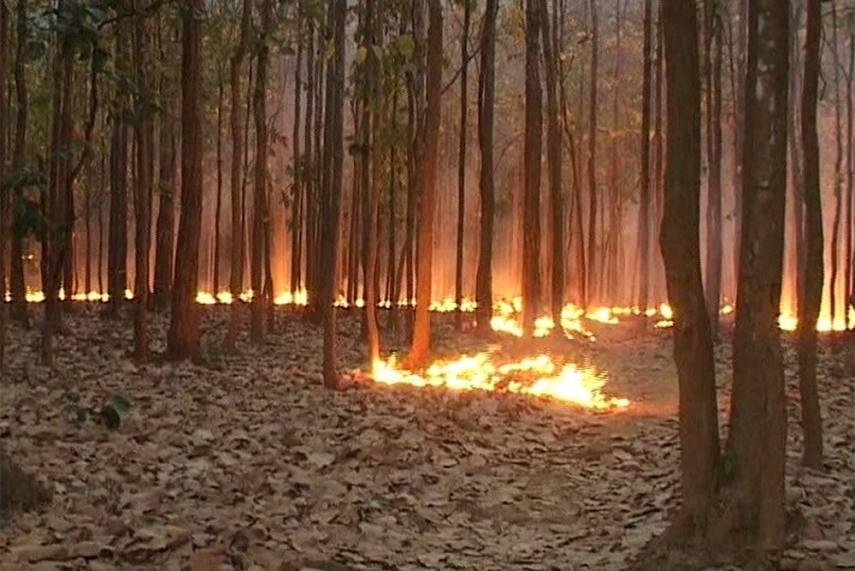Forest Fires in North India: A Man-Made Disaster

Representational Image. Image Courtesy: Outlook India
It is just the first week of April and forest fires have nearly started engulfing large tracts of forest land in Uttarakhand and Himachal Pradesh. Forty-five incidents of forest fires in the last 24 hours in Uttarakhand captured the headlines in most of the national dailies. Similar reports are coming from Himachal Pradesh as well.
In this scenario, both the state governments will have to ensure that they take decisions on a war footing for not letting the situation become extremely precarious. However, signs of desperation, impulsiveness and bureaucrat-driven interventions are already being reported in the press. The Chief Minister of Uttarakhand is pushing for helicopters for managing these fires; instead, it is the people that must be in the forefront, the earlier learnt, the better.
Forest fires in the mountains are not a new feature, thanks to the successive governments’ policies of monoculture plantation. It is equally abetted by massive dole out of funds from the World Bank for pushing green cover and planting varieties which were exotic to mountains and highly effervescent- we will return to this point later. But for now, more important is the early start of these fires which can be disastrous as a long spell of summers is to follow for at least 60 more days.
One of the foremost reasons cited is the obvious climate change and its repercussions on the entire geographical region. Less snow, relatively dry winters, even lesser rainfall in the mid-Himalayas from 3,000 feet to almost 7,000 feet altitude, etc., are the other reasons cited. But this is a classical style of expression, giving excuses and evading responsibility – of government agencies, forest department and the disconnect between the people, the forest right holders/ the forest dwellers and the government agencies.
Forest fires are a man-made phenomenon with faltered interventions at many layers, let us discuss that. So, what is required is to step up disaster risk reduction measures and work more on adaptability.
A paradigm shift in the plantation policy was brought in the state of Himachal Pradesh, under the aegis of the World Bank that pushed for increasing the green cover in the state. Species of trees that would grow quickly were planted. Chir pine is one of the species which was taken up on a war footing for plantation as it grew quickly even in arid zones. Pine is not a natural species of the Himalayas, the British brought it and planted it in their TB (tuberculosis) sanatoriums for fresh air.
Also read: Odisha: Similipal Fires Continue While Govt Claims Situation Under Control
The mountain governments, in both Uttarakhand (then UP) and Himachal undertook massive plantation drives and planted them even in mixed forests and grasslands. Sanjeeva Pandey, a well-known forester and a former IFS (Indian Forest Services) officer of Himachal cadre terms such drives as “Pine Colonising”.
Pine plantation colonised the native forests and created havoc after a few years. Why? Because the pine trees drop needles that are highly effervescent and are responsible for these fires. Secondly, no green vegetation survives beneath the pine tree, the only exception is Lantana Camara, which is another exotic species and has denuded large tracts of forests in the mountains, also an enhancer of forest fires. Thirdly, the pine tree roots are deep and suck water even from deep rocks and turn the region into an arid zone. No water body remains beneath a pine forest.
There are instances where, Sanjeeva Pandy points out, the names of some of the villages in Kullu district were linked with the composition of the forests. Most of these forests were linked with oak variety of trees, which is best suited for the mountains. However, oak was mercilessly cut down for fuel and charcoal making, following which pines have taken over most of these villages. Oak trees are one of the finest water coagulants and the large oak forests in the region, especially around Shimla town – Taradevi and Shoghi, have some of the finest water bodies.
It is high time that both these governments start revisiting their plantation strategies and completely disband using pine in these drives.
The second important reason is the massive alienation of the mountain people from forests. Interestingly, the forest dwellers had their rights in forests registered for long. The British, while monopolising their control over Indian forests in 1865, introduced the Forests Rights Act in the same year.
Also read: Forest Fires Rage in Himachal, Uttarakhand
Even back then, the rights of the traditional forest communities were secured under a provision called Wazi Wul Urge. The rights of the forest communities were restricted but registered. These rights included the right to timber for the construction of houses, grazing animals and access to fodder and fuel. Forests are part of the “village commons”. But currently, the governments have tried to encroach this thin line to appease big capital, that consider forests as a mere resource for aggrandising them for maximising their profits.
The commons amount to the rights of the people over land, water and forests. This is being seriously encroached upon by private corporate interests facilitated by the successive governments. The Himachal government draws a higher distinction in it. It withdrew some of the amendments in the provisions of giving a no-objection certificate by the village community through its gram panchayats. This was done to appease companies like hydropower, cement etc. Sanjeeva Pandey said that forests must be considered as a complete ecosystem and the present discourse of mere development would not only shun the people away from the forests, but this strategy will also completely ruin the forests.
Not only that, the same people who were protectors and guards of the forests are now considered encroachers. Not a single case of the Forest Rights Act 2005 has been settled in these mountain states. On the other hand, the government has stated that all forests rights are settled long ago, not realising that some of the land pattas awarded to the people in the 1980s are still not recognised and land entitlements have not followed yet. In such an environment the people are forcibly alienated from the forests which were part of the larger ecosystem including their habitat.
The third reason pertains to the overall slide in governance and limiting human resources to meet the fiscal deficit standards in the states. Earlier the Forest Department used to employ “Forest Rakhas(forest protectors)” from amongst the villagers. But for many years now this scheme is long gone and some of those employed in the Forest Department work as domestic help in the officers’ quarters.
Also read: Forest Fires Tripled in Last Four Months, Says Forest Survey of India
The natural guards of the forests are the people and it is they who should be prioritised in the larger strategy of forest management. Instead, the governments are handing over forests to private capital for extracting profits, minerals, water, forest wealth etc., and all of this is being used to keep aside the forest dwellers. This is not a sustainable model, rather it would be perilous for the forests and the people.
The strategy of what to plant would also play a big role in not just managing forests but also controlling forest fires.
People and not helicopters will manage the forests and fires. It is high time that we realise that.
(The writer is former deputy mayor of Shimla. The views are personal.)
Get the latest reports & analysis with people's perspective on Protests, movements & deep analytical videos, discussions of the current affairs in your Telegram app. Subscribe to NewsClick's Telegram channel & get Real-Time updates on stories, as they get published on our website.
























